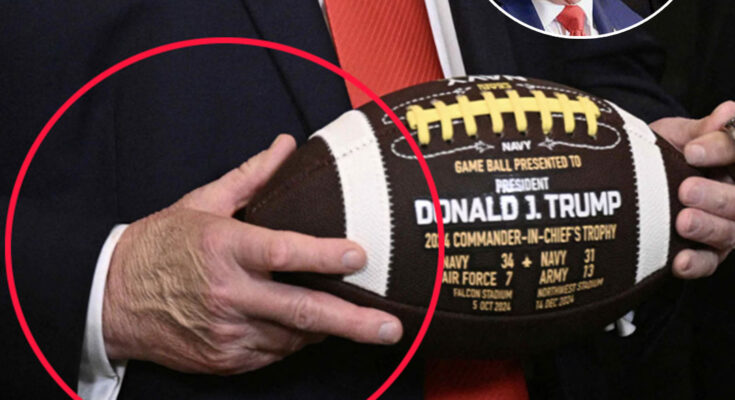He stood proudly, holding a custom football bearing his name while honoring the Navy Midshipmen football team for their Commander-in-Chief’s Trophy win. A championship ring sparkled on his hand, but it wasn’t enough to distract from what many couldn’t stop noticing: the reappearance of a curious bruise on Donald Trump’s right hand.
This isn’t the first time a mark on the former president’s hand has stirred public attention and online debate. Months earlier, during a meeting with French President Emmanuel Macron marking the third anniversary of Russia’s invasion of Ukraine, images of Trump’s bruised right hand triggered a flurry of concern and commentary. What was supposed to be a politically significant event quickly shifted focus as sharp-eyed viewers zeroed in on the discoloration.
Social media users were quick to weigh in. “Scrolling Getty and couldn’t help but notice this photo of a huge bruise on Trump’s hand today,” one user posted. Others dug deeper, pointing out similar marks in past photos. “Some photos over the last few months show bruising on Trump’s hand… Always seems to be on the same hand,” another noted. Some suggested the mark resembled one caused by an IV, often seen in patients on blood thinners. There was even speculation that Trump had tried to conceal it with makeup, a theory supported by a Getty caption noting visible coverage.
At the time, White House Press Secretary Karoline Leavitt brushed off concerns. “President Trump is a man of the people and meets more Americans and shakes more hands on a daily basis than any other president in history,” she said, adding that the bruise was simply a result of his energetic public engagement.
Yet, the bruise returned in mid-March, photographed again on Trump’s right hand. The internet lit up once more, and so did expert analysis.
Dr. Anatalia Moore, a skin specialist, cast doubt on the handshake explanation, telling The Mirror that it’s unlikely a bruise of that size would come from ordinary contact. “A deeper bruise on the hand in an older patient or someone of Donald Trump’s age would make me think firstly they had required some medical support that involved placement of a cannula,” she said, referring to procedures involving an IV or drip. Moore noted that even small bumps can leave large marks on older skin.
Then, on April 15, the bruise made another public appearance as Trump welcomed the Navy Midshipmen to the White House. In a celebratory event recognizing the team’s dominance over Army and Air Force, Trump’s remarks praised the athletes as warriors—but for many watching, the president’s hand overshadowed the football ceremony. A greenish-yellow mark, partially masked by what appeared to be makeup, stood out once again.
Commenters online speculated wildly. Some believed the mark matched that left by an IV; others suggested it could indicate medical treatment such as fluid replacement or a response to vitamin deficiency. Others proposed a more benign explanation: a simple bump or pressure point aggravated by age.
Dr. Ola Otulana, a UK-based general practitioner, leaned toward that interpretation. Speaking to the Daily Mail, he described the bruise as “consistent with a superficial contusion,” most likely caused by minor trauma. “This could occur from something as everyday as bumping the hand against a hard surface, repeated pressure—like leaning on a cane—or even medical procedures such as venepuncture,” he explained.
He emphasized that aging skin is more prone to visible bruising due to thinning and more fragile blood vessels. Medications like Aspirin or blood thinners could also contribute to prolonged discoloration.
With no direct confirmation beyond press statements, the speculation continues. Whether the mark is the result of normal aging, minor injury, or something more medically significant remains unknown.
For now, observers can only guess. What do you think is causing the repeated bruising? Share your thoughts—and your theories. This mystery has become one more topic where the public wants answers, even as official explanations remain minimal.



